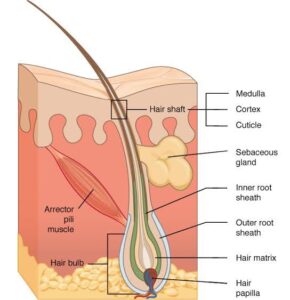Humans have been removing hair since – and possibly before – the ancient civilizations of Egypt. Both men and women in Ancient Egypt shaved the hair from their bodies and heads, for the dual reasons of cleanliness and fashion. Lice were a frequent problem, and it was difficult to keep hair clean in the hot Egyptian climate; additionally, wigs were seen as both fashionable and cleaner than natural hair.
Hair removal remained important as a sign of civilization and social status. Roman soldiers – who shaved their heads to prevent hair-pulling in battle – coined the term ‘barbarian’ in reference to the un-barbered enemy.
Although it is relatively easy to keep hair clean today, hairlessness continues to be important as a cultural phenomenon. Skin is considered “flawless” if it is without acne, blemishes, and hair. This is especially true for women in America, where popular magazines and websites often publish articles with titles like “See Hairy Celebrity Slips: Armpits, Legs, Guess Who?”
Advanced technologies include the invention of the modern razor by K. C. Gillette in the late nineteenth century. More futuristic methods include electrolysis, in which an electric current is applied to the hair follicle. This method – not laser hair removal – is the only method approved by the FDA to remove hair permanently.
Lasers have always captured the public imagination, and laser hair removal was attempted almost as soon as lasers were invented. These early lasers were impractical and often caused skin damage due to ineffective hair targeting and lack of control over the power of the laser. It took forty years – from the invention of the laser in 1957 to 1997 – for scientists and dermatologists to engineer a practical laser hair removal system.
The Biology of Human Hair
Each follicle of hair has three different layers; the medusa, the cortex, the cuticle
he medulla makes up the center of the hair, the cortex surrounds the medulla and is made out of roughly straight keratin structures, and the cuticle is the outside of the hair, made up of flat cells laid out like roof shingles. The hair itself is part of a biological system that includes the follicle, where the hair grows, the sebaceous gland, which when infected produces pimples, and the arrector pili muscle, which causes goose bumps.
Two types of melanin, eumelanin and phomelanin, contribute to the pigment of human hair. Eumelanin colors dark hair, while phomelanin contributes to red hair. The melanin in hair is a chromophore – the part of a molecule responsible for its colour. Color, in human hair and in general, is caused by the absorption of wavelengths of light and the reflection or transmission of others. This property is what allows laser light to be selectively absorbed by hair and not the surrounding skin. However, to know exactly why this happens, you have to go back to quantum physics.
The Physics behind Laser Technology
In 1913, Neils Bohr postulated that electrons in atoms could only have discrete (quantized) orbits and energies. He stated that electrons could jump from one orbit to another by emitting or absorbing energy in amounts predetermined by the orbits themselves. Bohr proved his theory by discovering the atomic spectrum of the Hydrogen atom, which contains one electron. When the electron lost energy, it would emit a wavelength of light corresponding to the change in energy between the orbits. The emitted wavelength of light – if in the visible band of the electromagnetic spectrum – would correspond to a specific color. Although Bohr was not completely correct in his assessment of atomic structure, the concept of discrete spectra allowed for the development of lasers.
What is a Laser?
The term laser is an acronym for Light Amplification by Stimulated Emission of Radiation. In the most basic sense, a laser is a device that emits light of a specific wavelength. Charles Townes and Arthur Schawlow invented the modern laser in 1957. At the time, Townes had previously discovered a method of amplifying electromagnetic waves; however, he had used microwave radiation instead of visible or infrared radiation. The theory behind lasers – exciting atoms in pure gases or solids to produce specific wavelengths of light – had been known for years, but Schawlow put the theory into practice. The first laser was comprised of a long narrow cavity containing the desired atoms with silvered mirrors at each end. The reflected light rays caused more atoms to be energised and consequently radiate energy at the specific wavelength.
How Laser Hair removal works
The laser emits a wavelength of light that should be primarily absorbed by the hair and primarily reflected by skin, causing the hair follicle to heat up faster than the surrounding skin. This causes inflammation, which will kill the follicle that produces the hair. However, one should not expect to go in for a treatment and come out hairless – it can take up to three weeks for the affected follicles to shed the treated hair.A cooling gel is applied just before the laser hair removal process begins.No single laser works on the complete range of skin and hair types (skin color is less relevant than melanin content), since the laser hair removal system works based upon a difference between skin and hair color in order for the hair to absorb the light without burning the skin. Melanin under the skin – even if inactivated, will absorb rather than reflect light at the same rate as melanin of the same type in the hair. If the skin and hair absorb the light at the same rate, the laser will not be able to “target” the hair. For this reason, for many years laser hair removal was only possible for people with light skin and dark hair. However, new lasers have been invented that work for different skin and hair combinations. For example, the alexandrite laser – which has a relatively short wavelength (775 nanometers) – is effective on patients with lighter skin, although it is dangerous for patients with dark skin, while the neodymium-doped yttrium aluminum garnet laser – developed to have a longer wavelength (1064 nanometers) – works well on darker-skinned patients
A shorter pulse width with higher energy and a wider laser beam has been shown to be more effective at disabling hair growth but also runs the risk of collateral skin damage.
Even if scientists engineered a laser that was perfectly absorbed by hair and perfectly reflected by skin, patients would still have to make several treatments to become hairless in the desired region. There are three phases of hair growth: anagen, catagen, and telogen, in which follicles are either active or dormant. Laser hair removal only works on active, growing hair follicles, since this is when the follicle is most sensitive. (At this point in the hair growth cycle, the early Anagen stage, the hair is completely under the skin.) In order to have a high probability of treating most hair follicles at the time they are active, dermatologists suggest seven treatments spaced anywhere from three to eight weeks apart.
On an average, three to seven sessions are needed for optimal results. In most cases, patients experience minimal discomfort during and after the procedure / treatment. There’s usually little to no post-treatment downtime required.At Skinesis Clinique, Your providers are all verified for the treatment being offered and have experience at the international levels with a qualified Dermatologist during the treatment. Skinesis uses only top quality FDA approved products & brands and do not compromise on the quality of care. For more details, Click on https://skinesisclinique.com/laser-hair-reduction-full-body-vasant-vihar/






